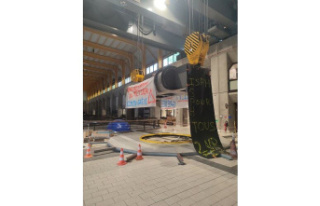Resupply is the Achilles heel of the invading Russian forces. It is mainly carried out by train and the supply must pass close to rails. Arms depots are easy prey for Ukrainian units, especially if they can use long-range guns.
Almost daily there are reports of explosions from Russian arms and ammunition depots along the Ukrainian front line. Almost as often are reports of partisan attacks in the occupied territories or in the allied Belarus on railway lines. These attacks could be decisive for the war, because they severely disrupt Russian supplies, which according to experts are mainly carried out by train.
The Russian army's dependence on rail is so great that 28,500 men are there just to repair and build railway lines, writes military expert Thomas C. Theiner. Russian depots are always located near railways. This is due to the fact that the troops lack logistics units, especially transport units. In addition, the Russian military is technologically backward and has neither cranes nor forklifts for loading material.
Trent Telenko, a former US Defense Department official, adds that Putin's invasion forces also lack pallets or ISO containers, which allow for easy and quick loading, moving, storing and unloading of goods. Instead, the Russian military deploys its soldiers.
The two military experts are not alone with their findings; the backward Russian logistics have also been discussed by other experts from the start. Again and again you see pictures of large piles of ammunition boxes, some of which are rotten.
According to Theiner, Russian supplies and ammunition are "loaded onto trains by hand, transported to the front, unloaded by hand there, loaded onto trucks by hand and then driven to the units at the front, where they are unloaded by hand again."
In order to supply the troops in the Donbass, a train with 3 to 4,000 tons of ammunition has previously traveled from Russia to Ukraine, Theiner writes. There he then stopped at various points 30 to 40 kilometers behind the front line, where the freight was then unloaded and stored. Drone videos by the Ukrainian army show that Putin's army, among other things, had tanks ammunition and refueled directly at the railway line or had heavy artillery fired directly from there.
According to the expert, the possibility of transporting supplies to the front by train explains the Russians' success to date in eastern Ukraine. "This allows Russia to bring forward the 10,000 tons of artillery ammunition it consumes each week and to send the replacement tanks, howitzers, etc. needed to replace Russia's immense material losses." The required fuel also gets to the front in this way.
They failed to do so near Kyiv, since Ukraine was able to defend the railway line running through Chernihiv and Sumy oblasts. The invaders would have had to cover the 300 to 350 kilometers of supplies from Russia by truck, "which failed spectacularly," says Theiner.
Like him, Telenko assumes after talks with Ukrainian soldiers that a Russian truck only has a radius of action of 90 to 100 kilometers from the train depot. The reason for this is that at this distance, the trip there and back alone takes around four hours, while loading and unloading by hand takes around three hours each. There are also breaks to eat or sleep, vehicle maintenance, etc.
So far it has been difficult for the Ukrainian army to destroy these camps as they were out of range of their artillery. However, both experts agree that this has changed fundamentally with the delivery of Western multiple rocket launchers (HIMARS) with precision-guided surface-to-surface rockets (GMLRS) or self-propelled howitzers.
According to Theiner, the self-propelled howitzers shoot up to 40 kilometers and are very accurate thanks to a GPS and radar-supported guidance system. According to the US military, the rocket launchers find their target at a distance of 85 kilometers with an accuracy of three to seven meters.
First of all, this means that the depots built by the Russians along the railway lines in the Donbass are now within range of Ukrainian artillery. Thanks to tens of thousands of patriots in the occupied territories, the Ukrainian army knows the locations of all Russian arms depots there, Theiner said.
Former Ukraine correspondent Tom Warner counted up to 30 HIMARS hits in Russian-held territory as of July 6, OSINT investigator Benjamin Pittet is collecting images and videos of suspected attacks on Russian arms caches behind the front line.
Telenko writes that once the Ukrainian army has destroyed the most important depots, it will use its newfound skills to take out Russian supply trains. They are much easier to find and hit than trucks and after a successful attack, the rails must first be cleared before they can be used again. "GMLRS means Russian logistics are finished."
Theiner shares this opinion. Russia is losing thousands of tons of ammunition through the attacks on the depots, which it cannot replace, and it is already having to transport old Soviet ammunition from Belarus to Ukraine. In addition, the trains would now have to stop 90 to 100 kilometers from the front and the ammunition would have to be loaded onto trucks there. However, the army has already lost a great many of these and with one transport per day and vehicle, not enough ammunition would probably arrive at the front and/or be distributed inefficiently.
"Whereas NLAW, Javelin and Stinger helped Ukraine win the Battle of Kyiv, now CAESAR, AHS Krab, PzH 2000 and most importantly GMLRS will help Ukraine win the Battle of Donbass and the Battle of Kherson", writes Theiner. "Because amateurs talk about strategy. Professionals talk about logistics."












